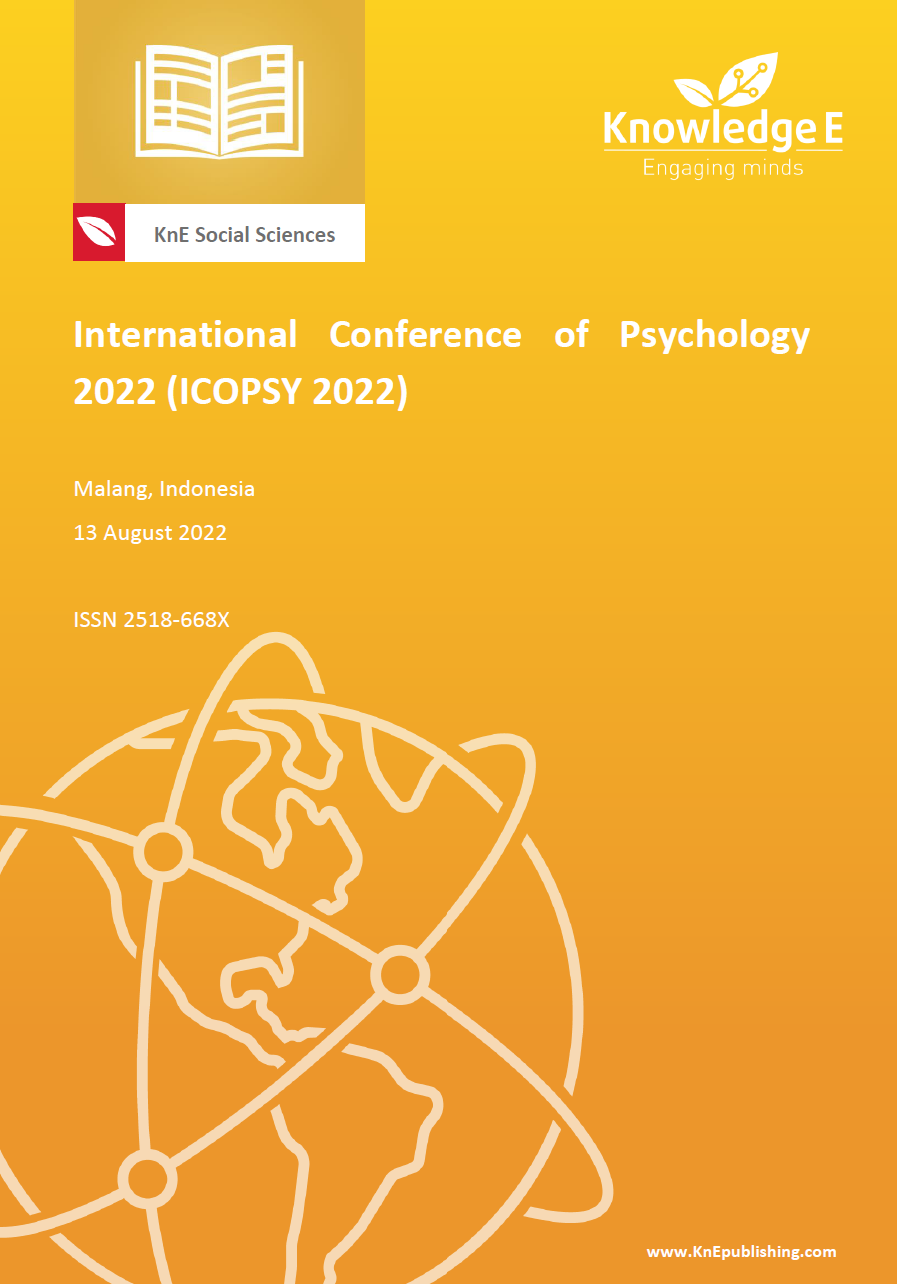The Relationship Between Coping Strategy and Nonsuicidal Self-injury on College Students with Broken Home Family Background
DOI:
https://doi.org/10.18502/kss.v7i18.12380Abstract
Nowadays, the issue of awareness regarding the mental health of students needs more attention. Students are prone to experiencing problems related to mental health, such as nonsuicidal self-injury (NSSI). Thus, it is important to conduct research on NSSI in students especially for students with broken home family backgrounds, who are more prone to experiencing NSSI. This research aims to determine the relationship between coping strategies and nonsuicidal self-injury in students with broken home family backgrounds. The study included 100 students who had a broken home family background and did nonsuicidal self-injury. The instruments used in this research were the coping strategy scale and the Inventory of Statements About Self-Injury (ISAS) scale. This research used a quantitative approach with descriptive and correlational research types. The correlation coefficient value obtained was -.427 with a significance of .000 (p < .05). It means that there was a relationship between coping strategies and nonsuicidal self-injury in students who had a broken home family background with a negative relationship direction. It means that the higher the coping strategy, the lower the nonsuicidal self-injury. This research provides information that is expected to be used for nonsuicidal self-injury students to apply more positive coping strategies to prevent and intervene in nonsuicidal self-injury behavior.
Keywords: coping strategy, nonsuicidal self-injury, broken home
References
[2] Wilis SS. Konseling Keluarga (Family Counseling). Bandung: Alfabeta; 2015.
[3] Loeber R, Stouthamer-Loeber M. Family factors as correlates and predictors of juvenile conduct problems and delinquency. Crime and Justice. 1986;7:29–149.
[4] Jinting WU, Hairong LIU. Features of nonsuicidal self-injury and relationships with coping methods among college students. Iranian Journal of Public Health. 2019;48(2):270–277.
[5] Kwon H, Hong HJ, Kweon YS. Classification of adolescent suicide based on student suicide reports. Journal of Child & Adolescent Psychiatry. 2020;31(4):169–176. https://doi.org/10.5765/jkacap.200030
[6] Glenn CR, Klonsky ED. One-year test-retest reliability of the inventory of statements about self-injury (ISAS). Assessment. 2011;18(3):375–378. https://doi.org/10.1177/1073191111411669
[7] Whitlock J, Muehlenkamp J, Purington A, et al. Nonsuicidal self-injury in a college population: general trends and sex differences. Journal of American College Health: J of ACH. 2011;59(8):691–698. https://doi.org/10.1080/07448481.2010.529626
[8] Cipriano A, Cella S, Cotrufo P. Nonsuicidal self-injury: A systematic review. Frontiers in Psychology. 2017;8:1946. https://doi.org/10.3389/fpsyg.2017.01946
[9] Hidayati DS, Muthia EN. Kesepian dan Keinginan Melukai Diri Sendiri Remaja. Psympathic: Jurnal Ilmiah Psikologi. 2015;2(2):185-198. https://doi.org/10.15575/psy.v2i2.459
[10] Nock MK, Prinstein MJ, Sterba SK. Revealing the form and function of selfinjurious thoughts and behaviors: A real-time ecological assessment study among adolescents and young adults. Journal of Abnormal Psychology. 2009;118(4):816– 827. https://doi.org/10.1037/a0016948
[11] Andrews T, Martin G, Hasking P, Page A. Predictors of onset for non-suicidal self-injury within a school-based sample of adolescents. Prevention Science: The Official Journal of the Society for Prevention Research. 2014;15(6):850–859. https://doi.org/10.1007/s11121-013-0412-8
[12] Lazarus RS, Folkman S. Stress, appraisal, and coping. New York: Springer publishing company; 1984.
[13] Moran SM. Nonsuicidal self-injury in a college age population: The role of coping strategies and emotional intelligence. (Publication No. 27540152) [Doctoral dissertation, University of Hartford]. ProQuest Dissertations Publishing; 2019.
[14] Wester KL, Trepal HC. Coping behaviors, abuse history, and counseling: Differentiating college students who self-injure. Journal of College Counseling. 2010;13(2):141–154. doi:10.1002/j.2161-1882.2010.tb00055.x
[15] Williams F, Hasking P. Emotion regulation, coping and alcohol use as moderators in the relationship between non-suicidal self-injury and psychological distress. Prevention Science: The Official Journal of The Society for Prevention Research. 2010;11(1):33-41. https://doi.org/10.1007/s11121-009-0147-8
[16] International Society for the Study of Self-injury. What is self-injury? 2018. Retrieved from: https://itriples.org/about-self-injury/what-is-self-injury
[17] Massa N, Rahman M, Napu Y. Dampak Keluarga Broken Home Terhadap Perilaku Sosial Anak. Jambura Journal Community Empowerment. 2020;1(1):1–12. https://dx.doi.org/10.37411/jjce.v1i1.92
[18] Trujillo NP, Servaty-Seib H. Parental absence and non-suicidal self-injury: Social support, social constraints and sense-making. Journal of Child and Family Studies. 2018;27(5):1449–1459. https://doi.org/10.1007/s10826-017-0976-1
[19] Klonsky ED, Glenn CR. Assessing the functions of nonsuicidal self-injury: Psychometric properties of the inventory of statements about self-injury (ISAS). Journal of Psychopathology and Behavioral Assessment. 2009;31(3):215–219. https://doi.org/10.1007/s10862-008-9107-z
[20] Hill K, Dallos R. Young people’s stories of self-harm: a narrative study. Clinical Child Psychology and Psychiatry. 2012;17(3):459–475. https://doi.org/10.1177/1359104511423364
[21] Beaton DE, Bombardier C, Guillemin F, Ferraz MB. Guidelines for the process of cross-cultural adaptation of self-report measures. Spine. 2000;25(24):3186–3191. https://doi.org/10.1097/00007632-200012150-00014
[22] Sugiyono S. Metode penelitian kuantitatif kualitatif. Bandung: Alfabeta; 2006.
[23] Lin MP, You J, Ren Y, et al. Prevalence of nonsuicidal self-injury and its risk and protective factors among adolescents in Taiwan. Psychiatry Research. 2017;255:119– 127. https://doi.org/10.1016/j.psychres.2017.05.028
[24] Wester KL, Downs HA, Trepal HC. Factors linked with increases in nonsuicidal selfinjury: A case study. Counseling Outcome Research and Evaluation. 2016;7(1):3-20. https://doi.org/10.1177/2150137816632849
[25] Trepal HC, Wester KL, Merchant E. A cross-sectional matched sample study of nonsuicidal self-injury among young adults: Support for interpersonal and intrapersonal factors, with implications for coping strategies. Child and Adolescent Psychiatry and Mental Health. 2015;9(1):36. https://doi.org/10.1186/s13034-015-0070- 7

